|
1
|
Fine JD, Bruckner-Tuderman L, Eady RA,
Bauer EA, Bauer JW, Has C, Heagerty A, Hintner H, Hovnanian A,
Jonkman MF, et al: Inherited epidermolysis bullosa: Updated
recommendations on diagnosis and classification. J Am Acad
Dermatol. 70:1103–1126. 2014. View Article : Google Scholar : PubMed/NCBI
|
|
2
|
Coulombe PA, Hutton ME, Vassar R and Fuchs
E: A function for keratins and a common thread among different
types of epidermolysis bullosa simplex diseases. J Cell Biol.
115:1661–1674. 1991. View Article : Google Scholar : PubMed/NCBI
|
|
3
|
Coulombe PA, Hutton ME, Letal A, Hebert A,
Paller AS and Fuchs E: Point mutations in human keratin 14 genes of
epidermolysis bullosa simplex patients: Genetic and functional
analyses. Cell. 66:1301–1311. 1991. View Article : Google Scholar : PubMed/NCBI
|
|
4
|
Hiremagalore R, Kubba A, Bansel S and
Jerajani H: Immunofluorescence mapping in inherited epidermolysis
bullosa: A study of 86 cases from India. Br J Dermatol.
172:384–391. 2015. View Article : Google Scholar : PubMed/NCBI
|
|
5
|
Intong LR and Murrell DF: Inherited
epidermolysis bullosa: New diagnostic criteria and classification.
Clin Dermatol. 30:70–77. 2012. View Article : Google Scholar : PubMed/NCBI
|
|
6
|
Fine JD, Johnson LB, Weiner M, Li KP and
Suchindran C: Epidermolysis bullosa and the risk of
life-threatening cancers: The National EB Registry experience,
1986–2006. J Am Acad Dermatol. 60:203–211. 2009. View Article : Google Scholar : PubMed/NCBI
|
|
7
|
Sawamura D, Nakano H and Matsuzaki Y:
Overview of epidermolysis bullosa. J Dermatol. 37:214–219. 2010.
View Article : Google Scholar : PubMed/NCBI
|
|
8
|
Yasukawa K, Sawamura D, Goto M, Nakamura
H, Jung SY, Kim SC and Shimizu H: Epidermolysis bullosa simplex in
Japanese and Korean patients: Genetic studies in 19 cases. Br J
Dermatol. 155:313–317. 2006. View Article : Google Scholar : PubMed/NCBI
|
|
9
|
Steinert PM, Marekov LN, Fraser RD and
Parry DA: Keratin intermediate filament structure: Crosslinking
studies yield quantitative information on molecular dimensions and
mechanism of assembly. J Mol Biol. 230:436–452. 1993. View Article : Google Scholar : PubMed/NCBI
|
|
10
|
Li XL, Xiao SX, Peng ZH, Liu Y, Pan M and
Zhou SN: A mutation in exon 1 of keratin 14 resulting in a Chinese
family with epidermolysis bullosa simplex Dowling-Meara. J Eur Acad
Dermatol Venereol. 21:979–981. 2007. View Article : Google Scholar : PubMed/NCBI
|
|
11
|
Yuan H, Liu F, Xiao B, He Y, Liang Y and
Liu J: Mutation screening of entire keratin 5 and keratin 14 genes
and identification of a novel mutation in a Chinese family with
epidermolysis bullosa simplex Dowling-Meara. J Eur Acad Dermatol
Venereol. 22:1510–1512. 2008. View Article : Google Scholar : PubMed/NCBI
|
|
12
|
Wu JW and Xiao SX: A recurrent keratin 14
mutation in Dowling-Meara epidermolysis bullosa simplex in a
Chinese family. J Eur Acad Dermatol Venereol. 23:484–486. 2009.
View Article : Google Scholar : PubMed/NCBI
|
|
13
|
Deng W, Yuan P, Lai W, Chen M, Wang Y and
Dai S: A novel KRT5 mutation, p. Lys199Asn, is associated with
three subtypes of epidermolysis bullosa simplex phenotypes in a
single Chinese family. J Dermatol Sci. 64:241–243. 2011. View Article : Google Scholar : PubMed/NCBI
|
|
14
|
Kang TW, Lee JS, Kim SE, Oh SW and Kim SC:
Novel and recurrent mutations in Keratin 5 and 14 in Korean
patients with Epidermolysis bullosa simplex. J Dermatol Sci.
57:90–94. 2010. View Article : Google Scholar : PubMed/NCBI
|
|
15
|
Shinkuma S, Nishie W, Jacyk WK, Natsuga K,
Ujiie H, Nakamura H, Akiyama M and Shimizu H: A novel keratin 5
mutation in an african family with epidermolysis bullosa simplex
indicates the importance of the amino acid located at the boundary
site between the H1 and coil 1A domains. Acta Derm Venereol.
93:585–587. 2013. View Article : Google Scholar : PubMed/NCBI
|
|
16
|
Müller FB, Küster W, Wodecki K, Almeida H
Jr, Bruckner-Tuderman L, Krieg T, Korge BP and Arin MJ: Novel and
recurrent mutations in keratin KRT5 and KRT14 genes in
epidermolysis bullosa simplex: Implications for disease phenotype
and keratin filament assembly. Hum Mutat. 27:719–720. 2006.
View Article : Google Scholar
|
|
17
|
Murrell DF, Trisnowati N, Miyakis S and
Paller AS: The yin and the yang of keratin amino acid substitutions
and epidermolysis bullosa simplex. J Invest Dermatol.
131:1787–1790. 2011. View Article : Google Scholar : PubMed/NCBI
|
|
18
|
Bolling MC, Lemmink HH, Jansen GH and
Jonkman MF: Mutations in KRT5 and KRT14 cause epidermolysis bullosa
simplex in 75% of the patients. Br J Dermatol. 164:637–644.
2011.PubMed/NCBI
|
|
19
|
Stephens K, Ehrlich P, Weaver M, Le R,
Spencer A and Sybert VP: Primers for exon-specific amplification of
the KRT5 gene: Identification of novel and recurrent mutations in
epidermolysis bullosa simplex patients. J Invest Dermatol.
108:349–353. 1997. View Article : Google Scholar : PubMed/NCBI
|
|
20
|
Betz RC, Planko L, Eigelshoven S, Hanneken
S, Pasternack SM, Bussow H, Van Den Bogaert K, Wenzel J,
Braun-Falco M, Rutten A, et al: Loss-of-function mutations in the
keratin 5 gene lead to Dowling-Degos disease. Am J Hum Genet.
78:510–519. 2006. View
Article : Google Scholar : PubMed/NCBI
|
|
21
|
Guo L, Luo X, Zhao A, Huang H, Wei Z, Chen
L, Qin S, Shao L, Xuan J, Feng G, et al: A novel heterozygous
nonsense mutation of keratin 5 in a Chinese family with
Dowling-Degos disease. J Eur Acad Dermatol Venereol. 26:908–910.
2012. View Article : Google Scholar : PubMed/NCBI
|
|
22
|
Liao H, Zhao Y, Baty DU, McGrath JA,
Mellerio JE and McLean WH: A heterozygous frameshift mutation in
the V1 domain of keratin 5 in a family with Dowling-Degos disease.
J Invest Dermatol. 127:298–300. 2007. View Article : Google Scholar : PubMed/NCBI
|
|
23
|
Planko L, Böhse K, Höhfeld J, Betz RC,
Hanneken S, Eigelshoven S, Kruse R, Nöthen MM and Magin TM:
Identification of a keratin-associated protein with a putative role
in vesicle transport. Eur J Cell Biol. 86:827–839. 2007. View Article : Google Scholar : PubMed/NCBI
|

















